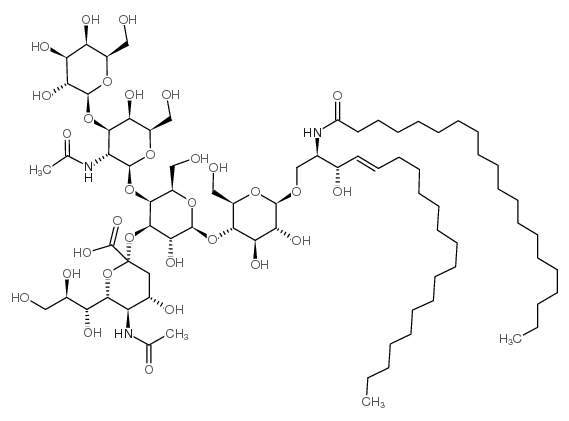Ganglioside GM1

Ganglioside GM1 structure
|
Common Name | Ganglioside GM1 | ||
|---|---|---|---|---|
| CAS Number | 37758-47-7 | Molecular Weight | 1602.93000 | |
| Density | 1.35 g/cm3 | Boiling Point | 1527ºC at 760 mmHg | |
| Molecular Formula | C77H139N3O31 | Melting Point | 207-230ºC | |
| MSDS | USA | Flash Point | 877.3ºC | |
|
Methylmercury causes neuronal cell death through the suppression of the TrkA pathway: in vitro and in vivo effects of TrkA pathway activators.
Toxicol. Appl. Pharmacol. 282(3) , 259-66, (2015) Methylmercury (MeHg) is an environmental toxin which induces cell death specific for the nervous systems. Here we show that MeHg causes neuronal cell death through the suppression of the tropomyosin receptor kinase A (TrkA) pathway, and that compounds activat... |
|
|
Ganglioside GM1-mediated transcytosis of cholera toxin bypasses the retrograde pathway and depends on the structure of the ceramide domain.
J. Biol. Chem. 288(36) , 25804-9, (2013) Cholera toxin causes diarrheal disease by binding ganglioside GM1 on the apical membrane of polarized intestinal epithelial cells and trafficking retrograde through sorting endosomes, the trans-Golgi network (TGN), and into the endoplasmic reticulum. A fracti... |
|
|
Fuzheng Huayu inhibits carbon tetrachloride-induced liver fibrosis in mice through activating hepatic NK cells.
J. Ethnopharmacol. 145(1) , 175-81, (2013) Fuzheng Huayu (FZHY) is a Chinese compound herbal preparation which consists of six Chinese herbs. This study examines the preventative effects of FZHY on liver fibrosis induced by carbon tetrachloride (CCl(4)) and explores its possible mechanisms of action.L... |
|
|
Molecular evolution of peptide ligands with custom-tailored characteristics for targeting of glycostructures.
PLoS Comput. Biol. 8(12) , e1002800, (2012) As an advanced approach to identify suitable targeting molecules required for various diagnostic and therapeutic interventions, we developed a procedure to devise peptides with customizable features by an iterative computer-assisted optimization strategy. An ... |
|
|
Partitioning and confinement of GM1 ganglioside induced by amyloid aggregates.
FEBS Lett. 587(9) , 1385-91, (2013) Growing evidence shows that GM1 ganglioside is involved in amyloid deposition and toxicity. By means of real-time single particle tracking, we show that amyloid oligomers and aggregates formed by Aβ1-42 and amylin, two peptides associated, respectively, with ... |
|
|
Altered levels of α-synuclein and sphingolipids in Batten disease lymphoblast cells.
Gene 539(2) , 181-5, (2014) Batten disease (juvenile neuronal ceroid lipofuscinosis) is a neurodegenerative disorder characterized by blindness, seizures, cognitive decline, and early death due to the inherited mutation of the CLN3 gene. Although α-synuclein and sphingolipids are releva... |
|
|
Reduced GM1 ganglioside in CFTR-deficient human airway cells results in decreased β1-integrin signaling and delayed wound repair.
Am. J. Physiol. Cell Physiol. 306(9) , C819-30, (2014) Loss of cystic fibrosis transmembrane conductance regulator (CFTR) function reduces chloride secretion and increases sodium uptake, but it is not clear why CFTR mutation also results in progressive lung inflammation and infection. We previously demonstrated t... |
|
|
CD1d favors MHC neighborhood, GM1 ganglioside proximity and low detergent sensitive membrane regions on the surface of B lymphocytes.
Biochim. Biophys. Acta 1840(1) , 667-80, (2014) Cluster of differentiation 1 (CD1) represents a family of proteins which is involved in lipid-based antigen presentation. Primarily, antigen presenting cells, like B cells, express CD1 proteins. Here, we examined the cell-surface distribution of CD1d, a subty... |
|
|
Botulinum neurotoxin G binds synaptotagmin-II in a mode similar to that of serotype B: tyrosine 1186 and lysine 1191 cause its lower affinity.
Biochemistry 52(22) , 3930-8, (2013) Botulinum neurotoxins (BoNTs) block neurotransmitter release by proteolyzing SNARE proteins in peripheral nerve terminals. Entry into neurons occurs subsequent to interaction with gangliosides and a synaptic vesicle protein. Isoforms I and II of synaptotagmin... |
|
|
Sex-dependent liver colonization of human melanoma in SCID mice--role of host defense mechanisms.
Clin. Exp. Metastasis 30(4) , 497-506, (2013) The possibility that endocrine factors may influence the clinical course of malignant melanoma is suggested by the superior survival data of women. In preclinical models we observed a higher rate of colony formation by human melanoma cells in male compared to... |